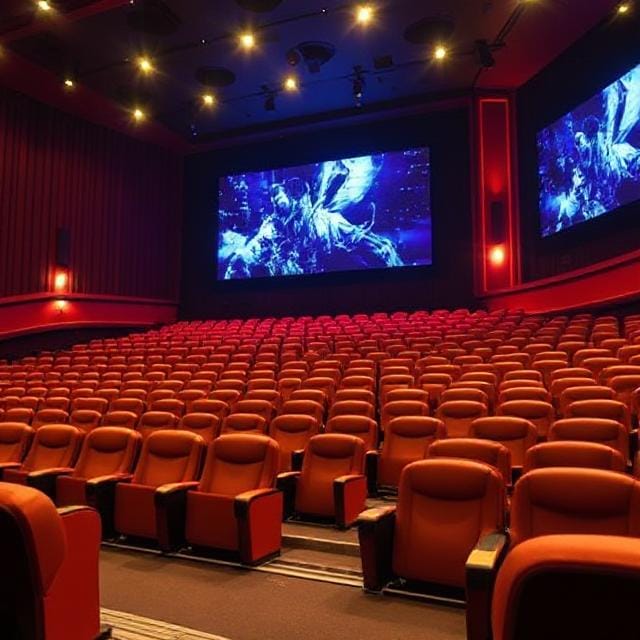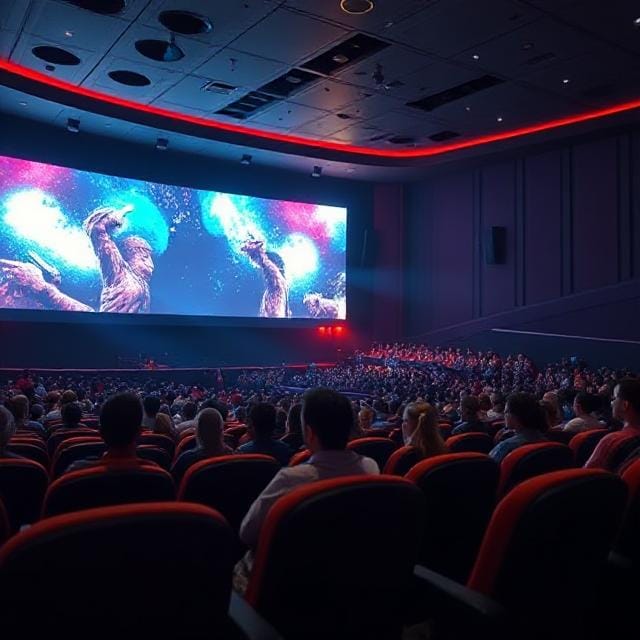
Table of Contents

🔹 1. Introduction
Motion picture theaters have long held a cherished put in social and social life. Starting within the early 20th century with nickelodeons and noiseless movies, theaters rapidly advanced into terrific royal residences of excitement, getting to be central gathering spots for communities. For decades, the movie-going encounter remained to a great extent unchanged—audiences run to cinemas to appreciate the most recent discharges on the huge screen, sharing in a collective enthusiastic travel.
In any case, the 21st century has introduced in emotional changes in how individuals expend excitement. The rise of computerized technology—particularly spilling stages, on-demand administrations, and domestic theater systems—has altogether disturbed the conventional theater demonstrate. With high-definition substance accessible at the touch of a button and personalized seeing encounters more available than ever, motion picture theaters have been constrained to reevaluate themselves to remain significant.
This web journal investigates the advancement of motion picture theaters within the computerized period, analyzing the challenges they confront, the advancements they’ve embraced, and what their future might see like in a world overwhelmed by advanced comfort.
🔹 2. The Rise of Digital Projection
Until a few years ago, large reels were needed to show films on the big screen. They were heavy, difficult to handle, and if played too many times, they would get damaged. But times have changed.
Now most theatres are using digital projection. This means that films are shown directly from the computer to the screen – without reels, without hassle. This makes the film’s images clear, the colours are good, and the quality does not deteriorate even if it is shown on the screen again and again.
This change has also benefited theatre owners. They no longer need to order heavy reels. Films are available through hard drives or the Internet, which reduces costs and also speeds up work.
In addition, a theatre can easily play several films in a day. Earlier, one film reel was put in, now just change the file and another film starts. Not only this, now matches, music shows and live events can also be shown in theatres.
Simply put, digital projection has transformed the entire theatre system — making it cheaper, faster, and smarter.

🔹 3. The Impact of Streaming Services
In the last few years, streaming platforms like Netflix, Amazon Prime, Disney+ have grown very fast. Today everyone has a phone or smart TV, and people have started liking watching new movies and web series sitting at home.
Earlier people used to go to the theater every week, but now habits are changing. People now watch the same movies sitting comfortably in their homes – watch whenever you feel like it, watch as many times as you want. There is no need to stand in line, nor wait for tickets.
This change has definitely shocked theaters. Many people feel that the era of theaters is coming to an end, but it is not so. Many big films are still released in theaters because their real fun comes only on the big screen – like action, thriller, or family films.
Now it is gradually happening that both theater and streaming are going hand in hand. Some films first come in theaters and after a few weeks on streaming. At the same time, some films are released directly on OTT.
The meaning is clear – streaming has changed people’s habits, but theaters still hold their place. Now there is less fighting, and more understanding – both are trying to get along with each other.
🔹 4. Enhanced Theater Experiences
When people started watching movies at home, the theatre owners also had to do something new to bring the audience back to them. This thought started the new era of theatres – where you get a complete experience, not just a movie.
Now many theatres use technologies like IMAX, 4D and Dolby Atmos. In IMAX, the screen is very big and the picture quality is amazing. In 4D, the chairs move, wind blows, even water splashes – as if you have become a part of the movie. And the sound quality of Dolby Atmos is such that the sound comes from every direction, a live feeling.
Not just technology, comfort is also being taken care of. Now many multiplexes have large and soft reclining seats, where you can watch the movie with your legs stretched out. Along with popcorn, you now get pasta, burgers, and even momos and mocktails. Some theaters have even started offering private screening rooms — for smaller groups, without the crowds.
In addition, some theaters are now introducing technologies like virtual reality (VR) and augmented reality (AR) to make the movie-going experience more immersive. Imagine — feeling like you’re in the scene of the movie!
Clearly, theaters are no longer just a place to screen a movie. They create an atmosphere where people feel something different and special — something that can never be found at home.
🔹 5. Changes in Movie Theater Business Models
As time changed, theatre owners also realized that the old way of working would not work. Now it has become difficult to earn money by just selling tickets. Therefore, they have changed their way of doing business – so that the audience comes again and again and feels something new.
Now many theatres have started offering subscription services. That means, pay a fixed amount every month and watch as many movies as you want – just like Netflix, but in the theatre. This benefits the audience as well as the theatre.
Loyalty programs are also running. The more times you go to watch a movie, the more points you get – and those points give you popcorn, coupons or discount on the next ticket. This makes people feel connected and makes them want to come again.
Now dynamic pricing is also running in theatres – like in flight tickets. On weekends or during a big movie, the tickets are a little expensive, and cheaper at other times. This ensures that seats do not remain empty and everyone gets an option according to their pocket.
And yes, now everything is connected to mobile apps. Be it buying a ticket, choosing a seat, or ordering popcorn – everything is done through the phone. Some theatres even take orders through an app and deliver food to your seat.
One thing is clear from all these changes – theatres are no longer just a place to show movies, they have now become a smart and customer-friendly business.
🔹 6. The COVID-19 Pandemic’s Impact
When the pandemic struck in 2020, every aspect of life came to a standstill — and the biggest impact was on cinema halls. Theatres remained shut for months, screens remained empty, and lakhs of people lost their jobs. Places that were once crowded became completely deserted.
The film industry suffered a major setback during this time. Films whose shooting had been completed could not be released. And those that were awaiting theatrical release were forced to be brought to OTT platforms. This is why the trend of digital release and hybrid model (theatre + streaming together) grew rapidly.
People also got used to watching new films by staying at home. Without masks, without fear, without crowds. This was the time when things like virtual cinema came into the picture — where films were released online but one had to buy tickets to watch them, with a theatre-like feel.
COVID made the theatre industry understand that just one way will not work anymore. Technology has to be embraced — whether it’s online booking, ordering food through mobile apps, or streaming movies in conjunction with digital platforms.
Though cinemas have reopened now, the pandemic has changed their face forever. Theatre owners now have to sell experiences, not just movies — and audiences want convenience along with safety.
🔹 7. The Future of Movie Theaters
Now that the COVID era is behind us, the question is — what next? Will theatres be able to regain their old glory? Or will digital platforms take over completely?
To be honest, theatres are making a comeback, but the path is not easy. People’s habits have changed — now they want comfort, convenience and options. In such a situation, theatres will also have to change themselves, and adopt new thinking and technology.
In the coming times, we may see more new experiences in theatres —
like personalized shows with the help of AI, or technology where you can choose the trailer or content of the film according to your choice.
With the help of hologram technology, it may seem that the characters are present in front of your eyes.
Interactive experiences can also come — where the audience can decide the story to some extent.
But most importantly, theatres need to recognise their true strength – which is the “collective experience” – watching a film together, applauding, sharing laughter, crying… something that cannot happen at home alone.
If theatres understand this, and connect with the hearts of the audience along with technology, they will not just survive – but shine again in the new era.
Digital platforms and theatres can co-exist if both keep their respective experiences unique.
🔹 8. Conclusion
The world of theatre has changed a lot in the last few years. It is no longer the era of reels, nor is it just about buying a ticket to watch a film. Now everything has gone digital – the screen is big, the sound is powerful, and everything is controlled on the mobile.
But amidst all these changes, one thing that is still the same – is watching a film in a theatre with friends or family. That laughter, that applause, that “whistle entry” – where do you get all this sitting at home?
Yes, now platforms like Netflix and Prime have made a lot of things easier, but the fun of theatre is still of a different level. Now we need to balance both – adopt the new age technology, and at the same time support the theatres around us a little.
Because if we do this, theatres will not only survive – but will become more fun and important than ever.
🔹 9. FAQs
1. Are streaming killing movie theaters?
No, theaters aren’t going away — but their challenges have certainly increased. People now prefer to watch movies from home, but the theater experience is still special. The big screen, great sound and the fun of watching a movie together is something that cannot be found on OTT. So theaters are now transforming themselves — with better technology, comfortable seats and a special experience.
2. What technologies make today’s theaters better than before?
Today’s theaters are not just screens and speakers — they have become a complete cinematic experience. Technologies like IMAX and 4D enhance the effect of screen and movement, Dolby Atmos brings sound effects to life. Apart from this, some theaters have also started offering personalized experiences through virtual reality (VR), mobile ordering and apps.
3. How are theaters adapting to changing audience habits?
Theaters are no longer just a place to show movies. Now there are many features like comfortable recliner seats, great food, online ticket booking, dynamic pricing and subscription models. Also, some films are released on both digital and theatre platforms – called a “hybrid release”. This is helping theatres to attract people who are now less likely to step out.
“best TV Shows That Accurately Depict Mental Health super 2025”







[…] “7 Powerful Ways Movie Theaters Are Evolving in the Digital Age” […]
hymytb
a8vxz8
Hello would you mind sharing which blog platform you’re using? I’m planning to start my own blog soon but I’m having a tough time selecting between BlogEngine/Wordpress/B2evolution and Drupal. The reason I ask is because your design and style seems different then most blogs and I’m looking for something completely unique. P.S Sorry for being off-topic but I had to ask!